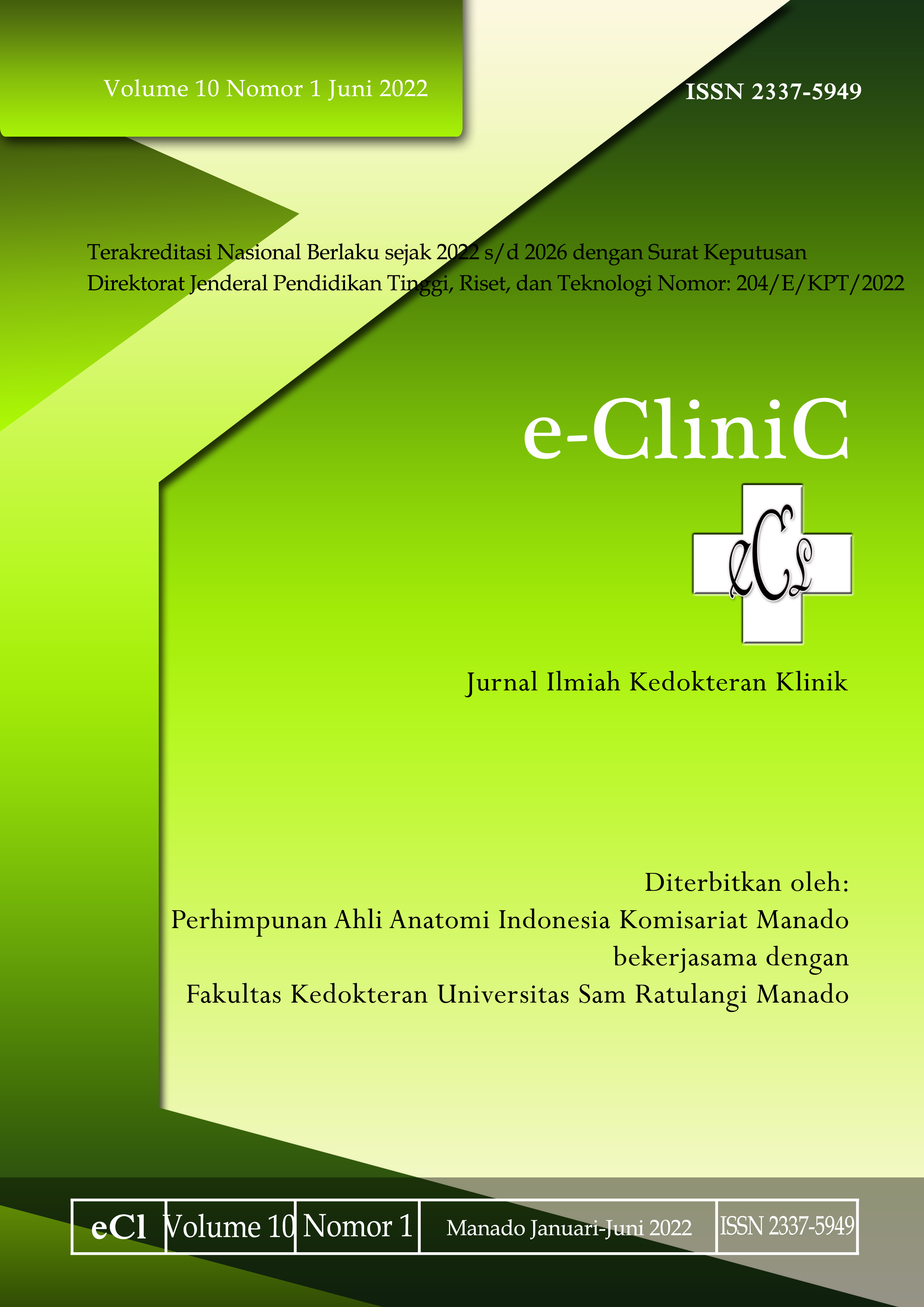Relationship between Nutrition Knowledge, Consumption Pattern and Physical Activity, and Body Image in Students during the Covid-19 Pandemic
DOI:
https://doi.org/10.35790/ecl.v10i1.37347Abstract
Abstract: Body image is an individual’s experience in the form of perception of his/her body shape and weight as well as behavior that leads to the individual’s evaluation of physical appearance. This study aimed to determine the relationship between nutritional knowledge, consumption pattern and physical activity, and the body image of students in the Covid-19 pandemic. This was a quantitative study with an analytical observational design using a cross sectional approach. Respondents were all students of Geothermal Specialization the Geothermal Specialization Department of Physics, Faculty of Mathematics and Natural Sciences at Manado State University totaling 88 people. The study instrument was in the form of questionnaire made into google form. The results showed that 71 respondents (80.7%) had a positive body image. The bivariate analysis using chi-square test showed a significant relationship between body image and nutritional knowledge (p=0.046), consumption pattern (p=0.000), and physical activity (0.014). Multivariate analysis using logistic regression showed that physical activity was the variable having most dominant relationship with body image (OR 3,245; 95% CI 1,239 – 8,502). In conclusion, there is a significant relationship between nutritional knowledge, consumption pattern, physical activity, and the body image of students in the Covid-19 pandemic. Physical activity is the most related factor with body image.   Â
Keywords: body image; nutritional knowledge; consumption pattern; physical activity
Abstrak: Body image merupakan pengalaman individu berupa persepsi terhadap bentuk dan berat tubuhnya, serta perilaku yang mengarah pada evaluasi individu tersebut terhadap penampilan fisik. Penelitian ini bertujuan untuk mengetahui hubungan antara pengetahuan gizi, pola konsumsi dan aktivitas fisik dengan body image mahasiswa pada masa pandemi Covid-19. Metode penelitian yaitu kuantitatif dengan rancangan observasional analitik dan desain potong lintang. Responden yaitu seluruh mahasiswa Peminatan Geotermal Jurusan Fisika Fakultas MIPA Universitas Negeri Manado berjumlah 88 orang. Instrumen penelitian berupa kuesioner, dibuat dalam bentuk google form. Hasil penelitian mendapatkan 80,7% responden memiliki body image positif. Hasil analisis bivariat dengan uji chi-square menunjukkan hubungan bermakna antara body image dengan pengetahuan gizi (p=0,046), pola konsumsi (p=0,000), dan aktivitas fisik (p=0,014). Analisis multivariat menggunakan regresi logistik mendapatkan bahwa aktivitas fisik merupakan variabel yang memiliki hubungan paling dominan dengan body image (OR 3,245; 95% CI 1,239 – 8,502). Simpulan penelitian ini ialah terdapat hubungan antara pengetahuan gizi, pola konsumsi, dan aktivitas fisik dengan body image mahasiswa pada masa pandemi Covid-19. Aktivitas fisik merupakan faktor yang paling berhubungan dengan body image.
Kata kunci: body image; pengetahuan gizi; pola konsumsi; aktivitas fisikDownloads
Additional Files
Published
How to Cite
Issue
Section
License
COPYRIGHT
Authors who publish with this journal agree to the following terms:
Authors hold their copyright and grant this journal the privilege of first publication, with the work simultaneously licensed under a Creative Commons Attribution License that permits others to impart the work with an acknowledgment of the work's origin and initial publication by this journal.
Authors can enter into separate or additional contractual arrangements for the non-exclusive distribution of the journal's published version of the work (for example, post it to an institutional repository or publish it in a book), with an acknowledgment of its underlying publication in this journal.
Authors are permitted and encouraged to post their work online (for example, in institutional repositories or on their website) as it can lead to productive exchanges, as well as earlier and greater citation of the published work (See The Effect of Open Access).







